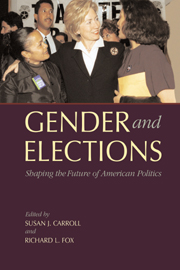Book contents
- Frontmatter
- Contents
- List of Figures, Text Boxes, and Photo
- List of Tables
- Acknowledgments
- List of Contributors
- Introduction: Gender and Electoral Politics into the Twenty-First Century
- 1 Presidential Elections
- 2 Voter Participation and Turnout
- 3 Voting Choices
- 4 Congressional Elections
- 5 African American Women and Electoral Politics
- 6 Political Parties and Women's Organizations
- 7 Advertising, Web Sites, and Media Coverage
- 8 State Elections
- Index
Introduction: Gender and Electoral Politics into the Twenty-First Century
Published online by Cambridge University Press: 05 June 2012
- Frontmatter
- Contents
- List of Figures, Text Boxes, and Photo
- List of Tables
- Acknowledgments
- List of Contributors
- Introduction: Gender and Electoral Politics into the Twenty-First Century
- 1 Presidential Elections
- 2 Voter Participation and Turnout
- 3 Voting Choices
- 4 Congressional Elections
- 5 African American Women and Electoral Politics
- 6 Political Parties and Women's Organizations
- 7 Advertising, Web Sites, and Media Coverage
- 8 State Elections
- Index
Summary
The 2004 elections in the United States will surely be remembered most for the hotly contested and deeply divisive presidential election between incumbent Republican President George W. Bush and Democratic challenger John F. Kerry. Because of the international and domestic controversy over the U.S.-led invasion of Iraq, the entire world was watching this election. The Democrats and John Kerry both tried to reassure voters that they could keep the country safe and to turn attention to domestic issues, such as jobs and the economy, where polls showed they had an advantage. In contrast, the Republicans and George W. Bush preferred to keep the public focused on homeland security and the fight against terrorism, where they had the upper hand. After Kerry wrapped up his party's nomination in March, more than seven months before the election, most polls forecasted a close race. Indeed, the race remained tight through election day. In fact, for the first time in history, the Gallup organization's final pre-election poll in 2004 projected the race as dead even, and the intensity of the campaign propelled a higher percentage of voters to the ballot box than at any time in the last forty years. Ultimately, President George W. Bush was re-elected by a margin of 51 to 48 percent, and Republicans strengthened their majorities in both the U.S. House and Senate.
- Type
- Chapter
- Information
- Gender and ElectionsShaping the Future of American Politics, pp. 1 - 11Publisher: Cambridge University PressPrint publication year: 2005
- 1
- Cited by



